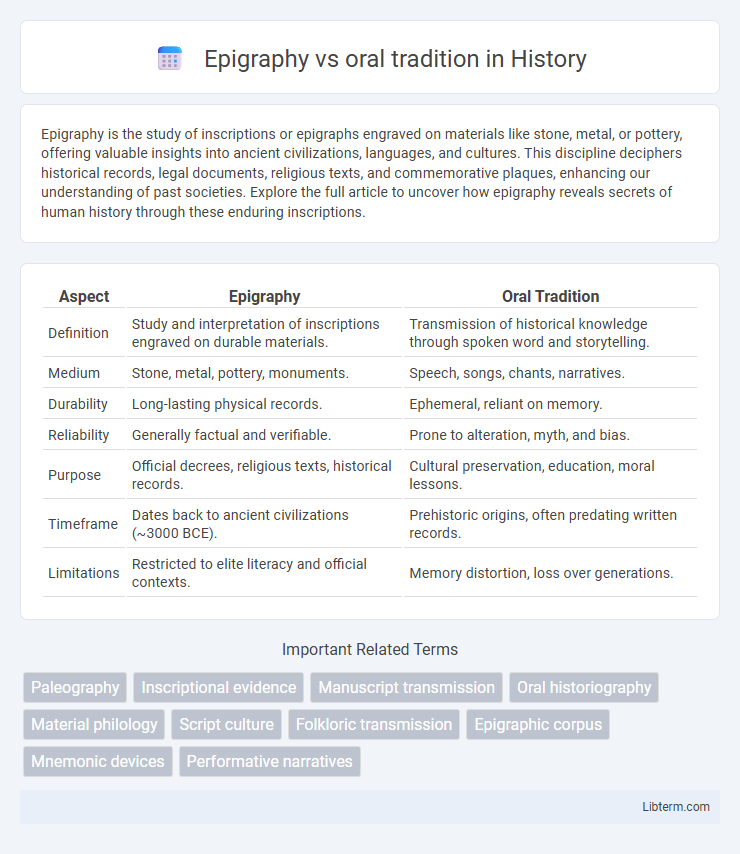Epigraphy is the study of inscriptions or epigraphs engraved on materials like stone, metal, or pottery, offering valuable insights into ancient civilizations, languages, and cultures. This discipline deciphers historical records, legal documents, religious texts, and commemorative plaques, enhancing our understanding of past societies. Explore the full article to uncover how epigraphy reveals secrets of human history through these enduring inscriptions.
Table of Comparison
| Aspect | Epigraphy | Oral Tradition |
|---|---|---|
| Definition | Study and interpretation of inscriptions engraved on durable materials. | Transmission of historical knowledge through spoken word and storytelling. |
| Medium | Stone, metal, pottery, monuments. | Speech, songs, chants, narratives. |
| Durability | Long-lasting physical records. | Ephemeral, reliant on memory. |
| Reliability | Generally factual and verifiable. | Prone to alteration, myth, and bias. |
| Purpose | Official decrees, religious texts, historical records. | Cultural preservation, education, moral lessons. |
| Timeframe | Dates back to ancient civilizations (~3000 BCE). | Prehistoric origins, often predating written records. |
| Limitations | Restricted to elite literacy and official contexts. | Memory distortion, loss over generations. |
Introduction to Epigraphy and Oral Tradition
Epigraphy involves the study and interpretation of inscriptions engraved on durable materials such as stone, metal, or pottery, providing direct and permanent records from ancient civilizations. Oral tradition encompasses the transmission of culturally significant stories, histories, and knowledge through spoken word across generations, relying on memory and performance rather than physical records. While epigraphy offers tangible evidence for historical analysis, oral tradition preserves intangible heritage and community identity through narrative and memorization techniques.
Defining Epigraphy: The Science of Inscriptions
Epigraphy, the science of inscriptions, involves the systematic study, interpretation, and preservation of ancient writings engraved on materials like stone, metal, or pottery, providing concrete historical evidence. Unlike oral tradition, which relies on spoken word and memory, epigraphy offers tangible, durable records that allow for precise dating and linguistic analysis. This discipline plays a crucial role in reconstructing past civilizations by decoding official decrees, religious texts, and everyday communications etched into permanent surfaces.
Understanding Oral Tradition: Memory and Transmission
Oral tradition relies heavily on memory and repeated verbal transmission to preserve cultural knowledge, often using mnemonic devices and storytelling techniques to maintain accuracy over generations. Epigraphy, by contrast, provides fixed, tangible records etched in durable materials like stone or metal, enabling precise documentation of historical events, laws, and beliefs. Understanding oral tradition highlights its dynamic, adaptive nature, while epigraphy emphasizes permanence and verifiability in the transmission of information.
Historical Significance of Epigraphic Evidence
Epigraphic evidence provides direct and durable records of historical events, laws, and societal norms inscribed on materials like stone, metal, or clay, offering a tangible connection to past civilizations. Compared to oral tradition, which can evolve or fade over time, inscriptions deliver precise dates, official decrees, and inscriptions of rulers that bolster the accuracy of historical research. The reliability and permanence of epigraphy make it essential for reconstructing ancient political, economic, and cultural histories.
The Role of Oral Tradition in Cultural Preservation
Oral tradition plays a critical role in cultural preservation by transmitting history, values, and beliefs through generations without written records. Unlike epigraphy, which relies on inscribed texts for documentation, oral tradition ensures the survival of intangible heritage such as folklore, music, and language nuances. This dynamic mode of cultural transmission fosters communal identity and resilience, especially in societies with limited access to literacy and formal record-keeping.
Strengths and Limitations of Epigraphic Sources
Epigraphic sources offer precise dates, names, and official proclamations carved in stone or metal, providing durable and authentic records that withstand the test of time. Their limitations include fragmentary preservation, potential biases of the inscriber, and restricted contextual information compared to oral tradition's flexibility and adaptability. Epigraphy's strength lies in its tangible evidence for historical verification, while its weakness is the frequently isolated and static nature of the recorded message.
Reliability and Challenges of Oral Narratives
Epigraphy offers a more reliable source of historical data due to its permanence and verifiability, while oral tradition faces challenges such as memory distortion and subjective interpretation. Oral narratives often evolve over generations, resulting in variations and potential loss of original details. Despite these challenges, oral tradition remains crucial for preserving cultural identity in societies lacking written records.
Comparative Analysis: Epigraphy vs Oral Tradition
Epigraphy offers tangible, permanent records etched on materials like stone or metal, allowing precise dating and direct access to historical data, while oral tradition relies on spoken narratives passed through generations, often subject to alterations and memory bias. Epigraphic evidence provides chronological anchors and material culture insights, whereas oral tradition preserves cultural values, customs, and collective memory in fluid, evolving forms. Both methods complement each other in reconstructing history, with epigraphy delivering fixed data points and oral tradition illuminating social context and intangible heritage.
The Interplay Between Written and Oral Records
Epigraphy preserves concrete historical data through inscriptions on durable materials, offering precise dates and formalized language, while oral tradition captures fluid narratives that evolve with cultural contexts, providing rich interpretative details. The interplay between written and oral records reveals complementary insights, with epigraphic evidence grounding oral histories in verifiable facts, and oral traditions filling gaps in the material record with contextual meaning. Scholars integrating epigraphic text analysis with ethnographic oral accounts gain a holistic understanding of ancient societies and their transmission of knowledge.
Conclusion: Synthesizing Insights from Both Approaches
Epigraphy provides concrete, durable records that anchor historical narratives with precise dates and tangible evidence, while oral tradition preserves cultural memory, offering nuanced insights into social values and collective identity across generations. Synthesizing insights from both approaches allows scholars to reconstruct a more holistic and dynamic understanding of past societies, balancing factual accuracy with interpretative richness. Integrating epigraphic data and oral narratives uncovers complementary perspectives that deepen historical analysis and cultural comprehension.
Epigraphy Infographic

 libterm.com
libterm.com